What would happen if you shot a cannon off in a canoe? You are probably going to get wet or die. In order to shoot a cannon, you need a stable platform. Likewise, your body needs a stable core to perform its activities of the day in a safe and powerful manner.
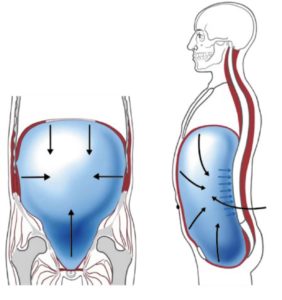
When we refer to a strong core, we do not mean the tight six pack abs of a young Arnold Schwarzenegger. Rather, it is the ability to use the diaphragm, muscles of the trunk, and the pelvic floor to produce intraabdominal pressure. This allows your spine to move well enough for proper function but also stable enough to produce power and stay injury free. Think of any throwing athlete, they have to be able to generate enough stability through their core to transfer generated power from their hips to their arm in order to throw the ball. However, if their spine stays rigid they can not generate enough range of motion to produce the speed that they need to throw the ball without their arm falling off.
When there is a lack of core strength the entire body can suffer due to the breakdown of stability throughout the entire kinematic chain of the body. Common dysfunctions related to a weak core are hip instability, poor thoracic extension, lumbopelvic instability, increased disc pressure and bulging, chronic back pain, decreased back and shoulder strength, TMJ pain, pelvic floor weakness, and more.
How do you train the core?
Most people assume that you need movement to train the core muscles. For many years exercises like sit-ups, crunches, deadlift, toe-to-bar, suspended knee raises, and more have been taught to improve abdominal strength and falsely thought to increase core strength. These exercises are often performed incorrectly with too much rounding of the spine greatly increasing injurious load to the spine and the disc. The leading spine researcher in the world, Dr. Stuart McGill, has repeatedly pointed out that anyone who sits all day long with a rounded spine, has poor posture with a rounded spine, or performs a job with a constantly rounded spine only needs to do a few sit-ups each day to eventually create their own disc bulge. Low back pain is a symptom of bad behavior not bad genetics. It is created by hundreds and thousands of small low load movements done in an improper way until something finally gives.
Even the military is finally changing its ways and getting rid of sit-ups in their fitness tests and training because of how injurious this exercise can be. Unfortunately, in many gyms, high schools weight rooms, and online instructional videos, many people are still taught to train the core muscles by moving through the spine and by doing so, they will have a flat belly. This way of training however, leads to injury, movement dysfunction, and decreased power and athletic performance.
Instead, we recommend you try these exercises in conjunction with seeing your local chiropractic specialist. A properly moving spine that is trained correctly to stabilize with intraabdominal pressure is the perfect kinematic engine to power you to your goals.
3 Month Supine
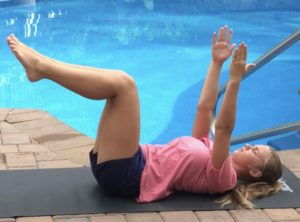 In the 3 month supine position (on your back, hips and knees both flexed to 90 degrees, without the legs touching each other, and hands straight up to the sky), begin by extending one slowly toward but not touching the floor. Alternate moving the legs for several repetitions. Next, perform a similar movement with one arm only, reaching overhead but never touching the floor. Repeat for several alternating repetitions with each arm. Continue to advance the exercise by moving a leg and the opposite arm at the same time. Alternate arms and legs with each repetition. Remember the point of this exercise is to maintain abdominal pressure deep into the pelvis.
In the 3 month supine position (on your back, hips and knees both flexed to 90 degrees, without the legs touching each other, and hands straight up to the sky), begin by extending one slowly toward but not touching the floor. Alternate moving the legs for several repetitions. Next, perform a similar movement with one arm only, reaching overhead but never touching the floor. Repeat for several alternating repetitions with each arm. Continue to advance the exercise by moving a leg and the opposite arm at the same time. Alternate arms and legs with each repetition. Remember the point of this exercise is to maintain abdominal pressure deep into the pelvis. 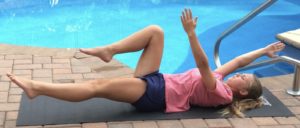 Do not let the lumbar spine arch, maintaining a flat back on the floor at all times. Only advance the exercise if you are able to maintain proper position and abdominal pressure. Repeat each variation of the exercise 7-15 times. You can find this video on our YouTube page here.
Do not let the lumbar spine arch, maintaining a flat back on the floor at all times. Only advance the exercise if you are able to maintain proper position and abdominal pressure. Repeat each variation of the exercise 7-15 times. You can find this video on our YouTube page here.
Side Bridge
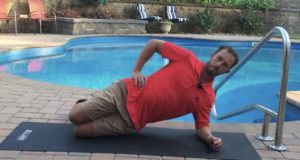 The side bridge can be performed effectively from your knees or with your legs extended. This exercise teaches the core muscles how to engage and stabilize the spine when lateral load is placed on it. Begin on one side, with your knees bent or your legs extended with one in front of the other. The downside elbow should be placed directly under the shoulder and your hand should be flat on the ground. Fill the lower belly with pressure and hold this brace while breathing in and out. Push the hips up off of the ground for a hold of 8-10 seconds. Maintain a straight line of head, shoulders, hips, and knees/feet during the bridge. Repeat for 1-3 sets per side. You can find a video explaining this exercise on our YouTube page here.
The side bridge can be performed effectively from your knees or with your legs extended. This exercise teaches the core muscles how to engage and stabilize the spine when lateral load is placed on it. Begin on one side, with your knees bent or your legs extended with one in front of the other. The downside elbow should be placed directly under the shoulder and your hand should be flat on the ground. Fill the lower belly with pressure and hold this brace while breathing in and out. Push the hips up off of the ground for a hold of 8-10 seconds. Maintain a straight line of head, shoulders, hips, and knees/feet during the bridge. Repeat for 1-3 sets per side. You can find a video explaining this exercise on our YouTube page here.
Bird Dog
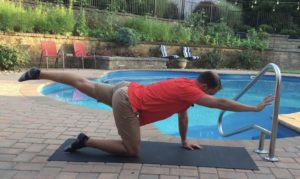 Begin on all fours with hands under your shoulders and your knees under your hips. Brace deep into your pelvis, while continuing to breathe, placing your spine in a neutral position. Start by sliding out one hand in front of you maintaining the neutral spine and abdominal brace. Return the hand and slide your other hand out. Repeat for each leg. If you can successfully perform these movements, try sliding one opposite arm and leg. Remember, that the goal of the exercise is to maintain core stability, not how far or fast you can move your extremities. Only move the arms and legs at a speed or depth that you are able to maintain the neutral spine and abdominal brace without excessively rotating through the hips or shoulders. Repeat each extremity movement for 5-20 repetitions. Check out our video for an advanced version of this exercise.
Begin on all fours with hands under your shoulders and your knees under your hips. Brace deep into your pelvis, while continuing to breathe, placing your spine in a neutral position. Start by sliding out one hand in front of you maintaining the neutral spine and abdominal brace. Return the hand and slide your other hand out. Repeat for each leg. If you can successfully perform these movements, try sliding one opposite arm and leg. Remember, that the goal of the exercise is to maintain core stability, not how far or fast you can move your extremities. Only move the arms and legs at a speed or depth that you are able to maintain the neutral spine and abdominal brace without excessively rotating through the hips or shoulders. Repeat each extremity movement for 5-20 repetitions. Check out our video for an advanced version of this exercise.
Core stabilization is achieved when the proper intraabdominal pressure is created by proper posture of the lumbar spine, proper strength of the trunk muscles, and proper control of the nervous system. This intricate balance of movement and stiffness can only be achieved with intentional training and coaching. It is our goal at [Core] Chiropractic to be the best resource for you and to provide you with the tools to keep your spine healthier than it has ever been. Email or call us if you have questions.

Daryl C. Rich, D.C., C.S.C.S.






